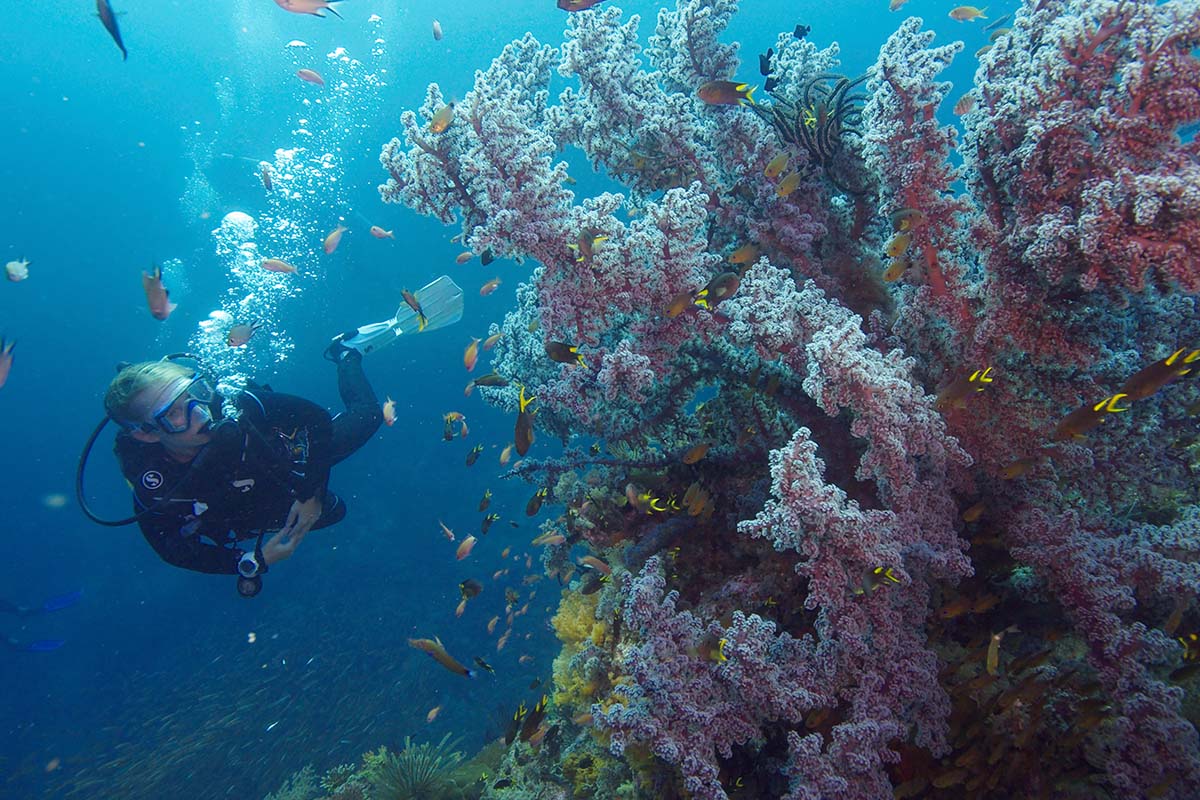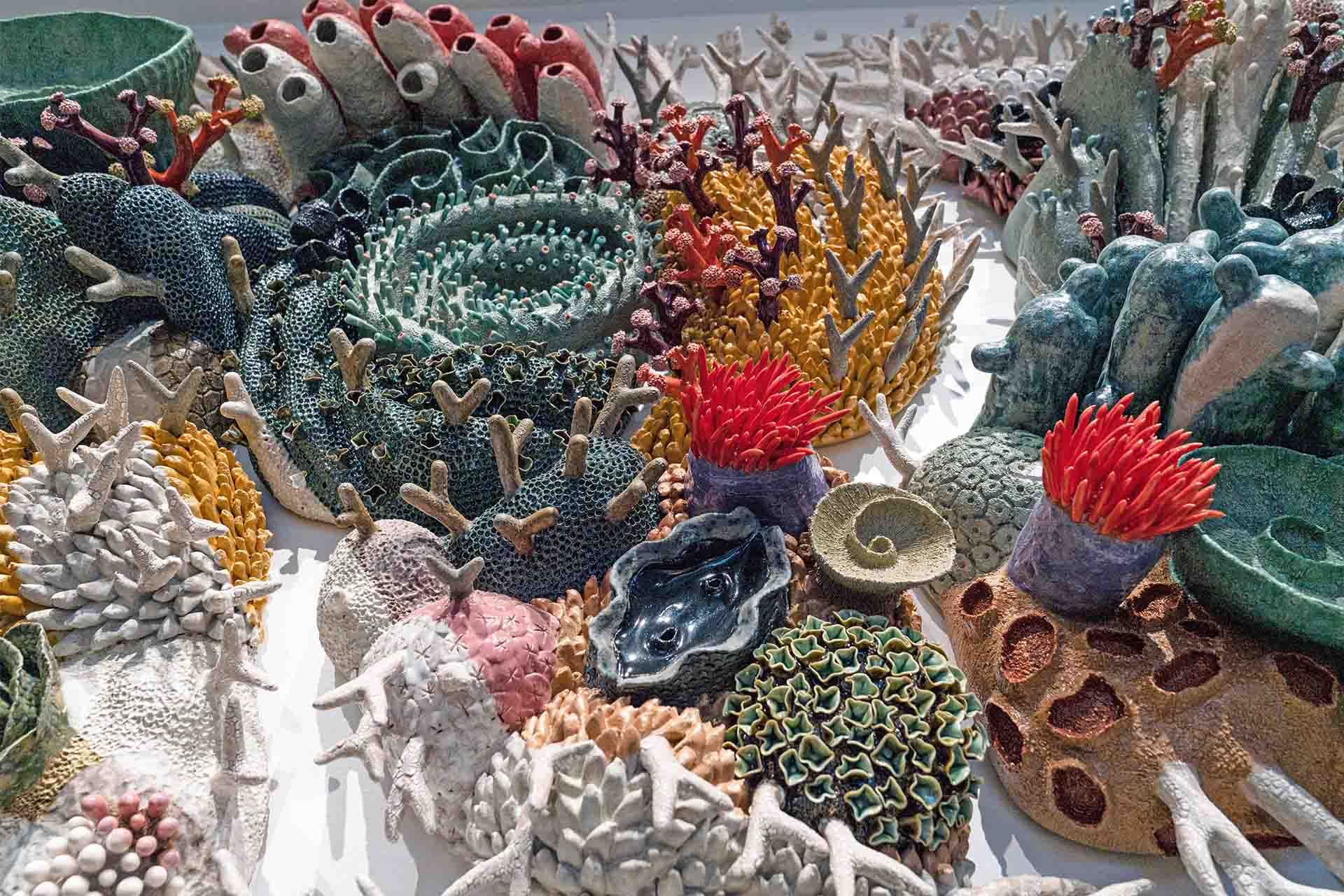By creating sculptures representing the anthropogenic issues affecting the ocean, Mattison creates a visual representation of the message of the scientific community
American artist Courtney Mattison – the reality of climate change’s impact on marine life
Through her complex and large-scale sculptural works, the American artist Courtney Mattison represents the reality of climate change’s impact on marine life. The San Francisco-raised and Los Angeles-based artist has a background in marine conservation science with an interdisciplinary Bachelor of Arts degree in marine ecology and ceramic sculpture from Skidmore College and a Master of Arts degree in environmental studies from Brown University.
Mattison’s sculptures have been part of art shows all over the United States. Among those in permanent view, there is the massive sculpture Confluence (Our Changing Seas V), which is in the permanent collection of the U.S. Embassy in Jakarta, Indonesia. Her artwork, Our Changing Seas I: A coral reef story is on view at the American Association for the Advancement of Science in Washington, D.C., through a long-term loan.
In the upcoming months, Courtney Mattison’s artworks will be displayed in the art show Fragile Earth: The Naturalist Impulse in Contemporary Art between September 24, 2022, and January 8, 2023, at the Brandywine River Museum of Art in Chadds Ford, PA. Then they will be displayed in the art show The Great Wave: Contemporary Art About the Ocean between September 19, 2022, and January 13, 2023, at the Santa Clara University in Santa Clara, CA.
The techniques, tools, and materials behind Courtney Mattison’s production of ceramic sculptural work
The materials used to create Mattison’s sculptural works are stoneware and porcelain ceramic. The materials known as ceramic, from the Greek word κεραμικός (keramikos), have been used to craft pottery objects for thousands of years. In her studio, Mattison utilizes this timeless medium to create artworks that visualize the beauty and fragility of natural coral reefs.
«I will start with a sketch. I’ll draw something with pen and ink and colored pencils by hand. Then I’ll scan that into Photoshop, map out my drawing and make it to scale so I can use it to superimpose it onto architectural renderings. As a lot of the work I do is by commission, I often need to make a proposal and get permission from a committee, client, or collector to move forward with the design concept. Once I have that approval, I will start creating that map I made in Photoshop on full scale on the floor of my studio. I have a large concrete floor in my studio in Los Angeles, and I will create a grid on the floor so I can measure everything in a careful way.
Hundreds of individual, hollow ceramic pieces constitute Mattison’s sculptures, which are made by pinching together clay coils. To add textures, the American sculptor utilizes simple tools and often mimics the repetitive growth of corals by poking holes in the individual pieces. «All the forms that I build are hollow ceramic. I texture them using a variety of elementary tools, like chopsticks and paint brushes, and I build appendages onto all these pieces».
«The diversity of coral reefs is a great inspiration for the different textures I use. Once the pieces are sculpted and completely built, I let them dry for as long as necessary. Sometimes that takes over a month. It depends on the size of the piece. Sometimes it only takes a few days. Once the pieces are dry, I put them in my kilns. I have two electric kilns at my studio, and I bisque-fire them to solidify the clay and chemically change it so it’s robust and can hold up to being glazed. Then I go through another whole process of glazing».
Courtney Mattison using color as a tool
The artist uses a vibrant color palette of glazes that mirrors that of healthy coral communities. Those rich colors are juxtaposed against white glazes in some of her artworks. This juxtaposition highlights the visual contrast between the state of healthy reefs and that of coral that suffered bleaching due to climate change. Such an approach was employed in the case of her 2018 sculpture “What will become”. Her 2019 glazed stoneware and porcelain wall relief sculpture ‘Malum Geminos’, representing bleached coral forms, is monochromatic, as it’s white in its entirety.
«I often incorporate different glazes, and I have a whole color palette of glazes developed over the years. I have about eighty different glazes that I use in combination. Oftentimes, glazing takes almost as long as building the pieces. Once everything is glazed, I put them back in the kiln, fire the pieces, and pull them out. Once I’m satisfied with the results, I’ll fit everything with hardware, measure everything again, and then pack it all up to install».
Art that takes time – Courtney Mattison’s crafting process
Several of Mattison’s artworks are large-scale and all her artistic production has an organic look. This naturalness is the result of a meticulous process that requires several steps, all carried out by hand and without the use of molds, as everything is hand built, hand textured, and glazed by the artist herself. Given these characteristics, the artist’s crafting process is a lengthy one. The piece’s scale influences the time it takes to complete its creation from start to finish.
«For some of my larger works, it can take about a year. Building some of the largest works I have done has taken about eight months, just the sculpting part, and glazing will often take a little bit less time».
Mattison’s and the first encounter with ceramic
The artist discovered ceramic as a teenager growing up in California. Exposed to clay as a student and through a family friend who worked as a potter and a sculptor, Courtney Mattison became familiar with this material. So much so that it felt natural to start using it to sculpt sea creatures when she first studied them in high school.
«When I was about 17 years old, I started taking my first marine biology class. I was fascinated with these invertebrate creatures that look like aliens, but they live in our own backyards. As a three-dimensional learner, it felt natural to start exploring them by sculpting them».
Art and activism – the inspiration to create
The relationship between art, activism, and politics is ancient and well-documented. The Italian painter of the Sienese school Ambrogio Lorenzetti painted the three fresco panels titled The Allegory of Good and Bad Government between 1338 and 1339 on commission by a civic group called the Council of Nine.
The Mary I miniature in the 1553 Michaelmas Coram Rege Rolls attributed by some historians to the Flemish miniaturist Levina Teerlinc is an allegory of power legitimized by God that celebrates her victory over the supporters of Lady Jane Grey, who had been declared queen after her first cousin once removed king Edward VI named her his heir.
Visual arts have retained their power to influence the political and social landscape of their time and can be a tool for individual activists and communities to inform and connect with the public to inspire change.
By creating sculptures representing the anthropogenic issues affecting the ocean, Mattison creates a visual representation of the message of the scientific community.
«Art has a job to do. Art, for art’s sake, is great and worthy of all kinds of attention and has its place in art history. But art has so much more potential to shape our understanding of our place in the world. Art and science have a lot in common. Scientists are often wary of advocating for anything because it might bias their data and research results. Artists have a freedom that many scientists don’t feel they have to creatively interpret the science of ecological threats like climate change and overfishing and translate them in emotionally impactful ways that can galvanize support and personal connection to issues like these that are so critical. Art and activism and advocacy are all interconnected».
Translating the reality of climate change into art
According to fifty-four percent of the Americans interviewed for a 2021 survey conducted by the Pew Research Center, climate scientists have too little influence on policy decisions related to climate change. Art, along with other forms of activism, can be a medium to bridge this gap.
«Climate change is an idea that is nebulous to many people. It’s hard to visualize climate change without seeing just the horrible things we see on the news, like flooding and catastrophic fires and the weather events threatening lives around the world. So there’s this big doom and gloom, guilt-ridden idea around climate change. Seeing it in a gentler, more personal way that is less scary and ferocious is an interesting way to think about it». Said Mattison.
«I want to try to help people have a different way of visualizing climate change through coral reefs. Coral reefs offer a stark way to do that as they bleach because they are sensitive to changes in seawater temperatures. So as the water warms and El Niño events become more common, the rapid temperature changes can make corals transition from these vibrant, beautiful, diverse colors into sickened, bleached white skeletons. That visual transition is spectacular in a way, even though it’s sad, and corals often die from bleaching. Visualizing it in that quiet, gentle way is powerful».
Courtney Mattison
Artist and sculptor Courtney Mattison was born in 1985 and raised in San Francisco. Her work represents the fragile beauty of marine life and has been commissioned internationally for permanent collections.




















